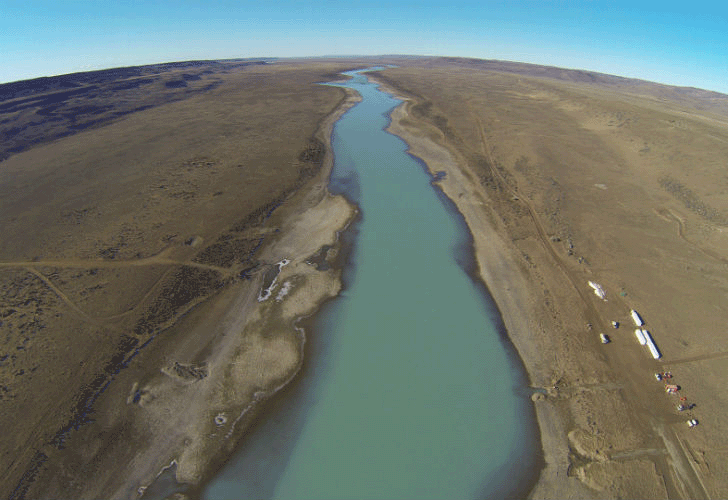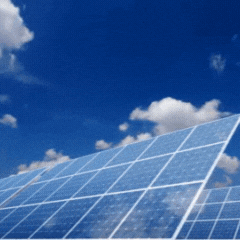#SantaCruz #Patagonia #Argentina #Dam #Kirchner #Cepernic #China #RenewableEnergy
Government seeks to restart project that has stalled in the courts, with its future relationship with China dependent on the construction of the Néstor Kirchner and Jorge Cepernic dams.The Santa Cruz river, photographed from the air. Foto:Cedoc.
Despite a legal limbo that remains in place for now, the mauricio macri administration is seeking to restart as soon as possible the construction of two controversial hydro-electric dams in Patagonia, projects that have been widely questioned by environmental groups but are seen as a necessity if the government is to unblock a greater flow of finances from China to Argentina.
The Néstor kirchner and Jorge Cepernic dams on the Santa Cruz river were given the green light from the national government this week, after the Energy and Environment ministries officially approved the construction of the project after carrying out a public hearing and a new environmental assessment report.
The decision leaves the ball in the judicial courts. The Supreme Court paralysed the construction of the dams in December 2016, asking the government for a new hearing and report. now that both these steps have been completed, the macri administration wants to break through the legal obstacles that remain and restart the project, perhaps even as soon as this month.
“There is no other way out but for the project to move forward. Argentina demands more electricity and needs this project. Completion of the dams frees up other projects which are now frozen and Argentina would guarantee immediate financing from China,” said Ernesto Taboada, the executive director of the Argentina-China Chamber of Commerce.
‘Completion of the dams frees up other projects which are now frozen and Argentina would guarantee immediate financing from China.’
The project dates back to the 1950s, though its feasibility was first studied in the 1970s under Argentina’s military dictatorship. However, the dams remained on the drawing-board until 2007, when former president Cristina Fernández de Kirchner relaunched the project, first naming the dams Condor Cliff and La Barrancosa and then renaming them in memory of her late husband and a previous Santa Cruz governor.
The dams will require a hefty investment of US$4.7 billion, of which Chinese banks will provide 85 percent. Chinese company Gezhouba and Argentine firms Electroingenería and Hidrocuyo will execute the project.
The construction, however, is far from just a business deal, it is also linked to a number of other deals with Beijing and has implications for foreign policy and other investment. For example, its progress is a necessary condition for the development of other projects lined up with China, such as upgrading the BelgranoCargas freight railway line.
“The government wants to please China so there’s no stopping this project. It can be delayed on judicial grounds but not forever,” said Ariel Slipak, an economist specialising in China and a Moreno University professor. “Macri’s priority is foreign investment and he will do whatever it takes to achieve that.”
«Ecological tragedy». On taking office, the Macri administration halted the development of the dams and modified the project. The power the dams would generate was scaled back from 1,740 to 1,310 megawatts (MW); the number of turbines was reduced from 11 to eight; the height of the dams was lowered to avoid negative impact and an additional high voltage line was constructed.
But that’s not enough to guarantee there will be no serious environmental impact, according to a coalition of environmental NGOs which have been campaigning against the project since its start. The same is true of the new environmental impact study, which was criticised in part due to the fact it contains no analysis of the impact of the power lines.
“Building the dams would be an enormous sacrifice and would cause an ecological tragedy. It won’t bring any development to Santa Cruz and it would create only a few shortterm jobs,” Andrés Nápoli, the executive director of the Environment and Natural Resources Foundation (FARN), said. “The government is in a rush to complete the dams because of its commitments to China.”
Environmental organisations such as FARN, Vida Silvestre and Aves Argentinas have warned of the potential environmental damage which dams could cause, including affecting the bio-diversity of the area and specifically the Upsala, Spegazzini and Perito Moreno glaciers, which UNESCO have declared a World Heritage Site.
For example, the hooded grebe (macátobiano) spends the winter months in the Santa Cruz River estuary, which has been declared an important bird conservation area by Bird Life International. Green groups say the construction of the dams will have serious consequences, not just for this species but for many others.
“There are still heavy odds against the dams being completed. If local justice doesn’t move forward, we could take the case to international courts as the government didn’t previously consult the indigenous people living in the dams area,” Manuel Jaramillo, Vida Silvestre’s executive director, said.
“Building these dams is a very bad deal, both for environmental and economic reasons.”
Demand and diversification. The government and energy experts see the dams as the lynchpin of a more diversified matrix, which they say requires continuous energy generation and an increased share of renewable energy. Almost 90 percent of Argentina’s energy matrix today depends on nonrenewable sources, particularly gas and oil, according to the International Energy Agency.
“The project is extremely important for the Argentine energy system. It allows for the addition of the energy we need. The dams have financing, with the initial works already having taken place, and it must go ahead. We do not see any inconveniences or circumstances which would require stoppages, but quite the opposite,” said Oscar Navarro, a member of the Argentine Committee for Major Dams.
But NGOs disagree, claiming such large hydro-electric plants can’t be considered renewable energy. Local legislation says dams of more than 50 MW can’t be qualified as such, mainly because of the major environmental impact they cause during their construction — something even the government admitted prior announcing a US$400-million mitigation and compensation plan.
Instead of spending such large sums on the dams, wind and solar energy plants could be given a boost in the country, NGOs argue, taking advantage of the interest of foreign investors in the sector and making sure there wouldn’t be any environmental impact.
The Macri administration has already launched the second round of the renewables promotion programme Renovar, aiming at allocating projects totalling 1.200 MW. In the first round, when 2.423 MW were allocated, half of the wind and three-quarters of the solar projects were linked to Chinese technology and capital.
“China has become a very important player in Argentina’s energy sector. There are many solar and wind power projects with Chinese technology and capital. China offers funding from its banks at very reasonable rates and that’s always very attractive. If the dams go through, investment should continue,” Taboada said.
According to recent legislation, Argentina must have eight percent of its electricity generated by renewable energy by the end of 2018, a target which should increase to 20 percent in 2025. It’s a long road, however, as currently less than one percent of the matrix is based on renewables. But most experts agree, the potential in Argentina for renewable energy is huge.
Asymetrical relationship. Over the past decade, Argentina’s relationship with China has grown substantially. In the last few years, the countries have signed more than 20 treaties and the nations now enjoy what’s called a “comprehensive strategic alliance,” a diplomatic status with Beijing enjoyed only by a few countries. Such a close relationship has led to a rush of Chinese investment in the country, totalling up to US$20 billion in loans to finance an array of projects.
While China has guaranteed funding for key energy and transportation works, such as dams and nuclear power plants, Argentina has authorised the awarding of works without a prior bidding process and opened the door for Chinese labour, a move that was initially questioned by the Argentine Industrial Union (UIA).
Progress on the construction of the dams is a key step toward unblocking and pushing forward other projects for which Argentina needs financing from China. These include renovating the fleet of trains and the network of the state-owned BelgranoCargas freight line in the central province of Santa Fe, in addition to the construction of two nuclear power plants.
The trade relationship between the two countries has been described as “asymmetrical” or unequal and both governments have acknowledged this publicly. Argentina has an annual trade deficit with China of around US$5 billion and more than 95 percent of Argentina’s exports to China are primary resources.
The relationship between both countries is longstanding but the current administration wasn’t quite so warm toward Beijing after taking office at the end of 2015. President Mauricio Macri initially questioned the relationship, citing the type of contracts signed and an apparent lack of transparency, pointing the finger and hinting at possible corruption in the close ties between China and the Kirchnerite governments.
However, Macri was forced to backtrack as the need for foreign funds was high and the promised investments from elsewhere didn’t turn up. Some analysts have said the contracts signed with Beijing were watertight and that the financial penalties for pulling such a deal would have hurt the government’s coffers substantially.
‘Building the dams would be an enormous sacrifice and would cause an ecological tragedy. It won’t bring any development to Santa Cruz and it would create only a few short-term jobs. The government is in a rush to complete the dams because of its commitments to China.’
Even some ministers have hinted at concern over the closeness of ties with Beijing.
“If we had no commitment to China, we probably would not have progressed at this speed,” Energy and Mining Minister Juan José Aranguren said at the recent public hearing about the dams. Environment Minister Sergio Bergman has also said publicly that contracts with China “influence the state.”
Saying no to China wasn’t possible for the president, though he managed to alter conditions regarding the dams. Chinese finance is a powerful tool of coercion in global affairs and Argentina wasn’t the exception. During Kirchnerism, the lack of international funding, due to the conflict with the so-called “vulture” funds made China a key partner.
“When appointed, Macri questioned the ties with China and even ordered the Coast Guard to sink a fishing-boat in Argentine waters as a show of strength. But now, with (US president Donald) Trump shutting off the US economy, Argentina will deepen its asymmetrical ties with China, which will carry out only the projects it chooses,” Slipak concluded.
By Fermín Koop
Source: Buenos Aires Times
























